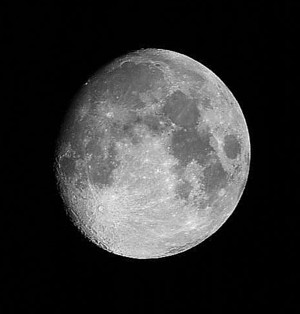[/caption]
If the Moon’s up, go take a look and see what color it is. If you’re looking during the daylight, the Moon will look faint and white surrounded by the blue of the sky. If it’s night, the Moon will look bright yellow. Why does the color the Moon seem to change from white to yellow when you go from day to night. And why does the Moon look gray in many photographs, especially the ones from space? What color is the Moon?
The photographs of the Moon, taken from space are the best true-color views of the Moon. That gray color you see comes from the surface of the Moon which is mostly oxygen, silicon, magnesium, iron, calcium and aluminum. The lighter color rocks are usually plagioclase feldspar, while the darker rocks are pyroxene. Most of the rocks that you can see are volcanic, and were extruded from the inside of the Moon during volcanic eruptions. Some rare rocks called olivine are actually green.
The dark regions you see on the Moon are called lunar maria, and they were formed by ancient volcanic eruptions. They’re less reflective than the lunar highlands, and so they appear darker to the eye. The maria cover about 16% of the lunar surface, mostly on the side we can see from Earth. Astronomers think the lunar maria were formed about 3-3.5 billion years ago, when the Moon was much more volcanically active.
When you see the Moon from here on Earth, the atmosphere partially blocks your view. The particles in the atmosphere scatter certain wavelengths of light, and permit other wavelengths to get through directly. When the Moon is low in the sky, you’re seeing its light go through the most atmosphere. Light on the blue end of the spectrum is scattered away, while the red light isn’t scattered. This is why the Moon looks more red. As it goes higher in the sky, the Moon is obscured by less and less atmosphere, so it turns more yellow – the same thing happens to the Sun as it rises in the sky.
During the day, the Moon has to compete with sunlight, which is also being scattered by the atmosphere, so it looks white.
Here’s an article from Universe Today about harvest moons, and here’s an article about how astronomers calibrate photographs from space.
Here’s an article that explains how to get the right color of the Moon in Photoshop, and here’s an article from Windows on the Universe about the Moon’s colors in fall.
You can listen to a very interesting podcast about the formation of the Moon from Astronomy Cast, Episode 17: Where Did the Moon Come From?
Reference:
http://www.nasa.gov/mission_pages/LRO/multimedia/lroimages/lroc-20100910_color_moon.html

